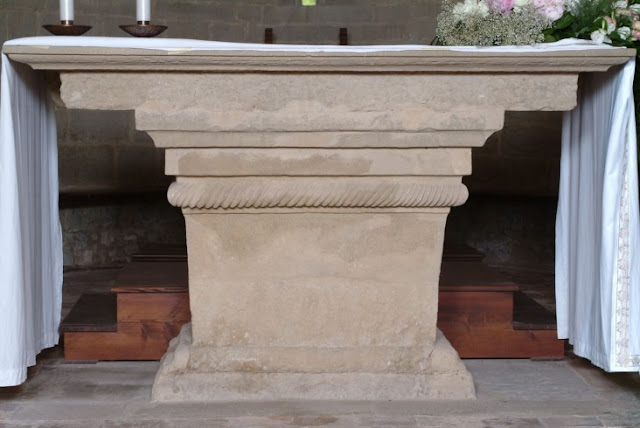One of the major issues with many table altars that appeared in the 1960's and 70's was that they were stylistically dated almost as soon as they were installed. They tended to lack noble materials (being frequently made of wood) or classical ornamentation of any sort, and many of them adopted the fetish of that particular time for a faux-primitivism that was concurrently combined with a kind of 1960's space-age futurism. In immediately succeeding decades of the 1980's and 90's, the approaches were sometime better, though still not particularly stellar.
However, if we take our cues from history we can certainly find some noble altars in table form, especially dated to the medieval period. Here are a few examples:
 |
| Altar of the Basilica of Santa Maria Assunta in Torcello |
 |
| The Norman era chapel of the Tower of London |
 |
| The mensa is medieval, the columns are 19th century. |
 |
| 11th-13th century, Italy |
 |
| 12th-13th century |
 |
| Pisa, 11th century |
 |
| 12th century |
 |
| Lombardy, 11th century |
 |
| 1114 |
Now, while one might well (as I do) still prefer the sarcophagus-style altar to these, all of these are worthy and noble altars in their own right. So why do they succeed where others might fail?
We begin with the material: stone. The use of stone goes a long way it helping combat the sense of impermanence and insubstantiality that so often accompanies many contemporary table-styled altars. What's more, generally the most successful examples are well proportioned and take similar rectangular proportions to tomb/sarcophagus styled altars. Such generally require supports to support the weight of the mensa of the altar, and these frequently take on classical architectural expressions such as columns. This not only lends further to the feeling of permanence and substance, they also provide an opportunity for ornamentation and avoidance of minimalism.
While each of the examples above were antique, here is a contemporary example, in this case combining elements of a sarcophagul altar with that of a table one:













